Mechanical and Acoustic Emission Characteristics of Grouted Reinforcement in Fissure-Containing Rock-like Specimens
Abstract
:1. Introduction
2. Experimental Methods
2.1. Fracture Specimens Preparation
2.2. Grouting Materials
2.3. Grouting Method
2.4. Uniaxial Compression Acoustic Emission Test
3. Test Results and Analysis
3.1. Strength Comparison of Grouted Reinforcement
3.2. Analysis of Damage Patterns
3.3. Analysis of Acoustic Emission Energy
4. Conclusions
- (1)
- Analysis from the perspective of grouted strength: The method of grouting reinforcement can improve the residual strength of the specimens to a certain extent, and the residual strength enhancement coefficient varies depending on the grouting material used; the residual strength of the ultra-fine cement grouting specimen was increased by 16.931%, the residual strength of the C-S grouting specimen was increased by 13.075%, and the residual strength of the MARITHAN® grouting specimen was increased by 39.998%. However, the peak strengths of the three types of grouted specimens were still reduced compared to the intact specimens, and their peak strength enhancement coefficients were negative, indicating that there is a limit to the increase in strength depending on the grouting method.
- (2)
- Analysis from the perspective of damage patterns: The damage pattern of the ultra-fine cement grouting specimen and the C-S grouting specimen showed shear-slip damage along the original rupture surface. The MARITHAN® grouting specimen was cracked from a position near the end of the specimen, and the grouting body was not damaged. This indicates that the ultra-fine cement slurry and C-S slurry do not exert very good reinforcing effects due to their low adhesion and permeability and that MARITHAN® can effectively improve the stress concentration caused by the crack, weaken the influence of prefabricated cracks on the macro-damage of the specimen, and exert a better reinforcing effect.
- (3)
- Analysis from the perspective of AE energy: The cumulative AE energy curves of grouted specimens showed obvious stage characteristics, and the distribution characteristics differed depending on the grouting material used. The AE energy value of the ultra-fine cement grouting specimen and the C-S grouting specimen increased sharply in Stage III, and there was a maximum value for the slope of the cumulative AE energy curve. The MARITHAN® grouting specimen and the intact specimen produced a large number of AE signals in Stage IV, and the maximum value for the slope of the cumulative AE energy curve was in this stage. This indicates that a large number of cracks were generated in the ultra-fine cement grouting specimen and C-S grouting specimen in Stage III, and the ultra-fine cement slurry and C-S slurry exert limited effects on the repair of internal damage to the specimen.
5. Discussion
Author Contributions
Funding
Institutional Review Board Statement
Informed Consent Statement
Data Availability Statement
Conflicts of Interest
References
- She, S.G.; Lin, P. Some developments and challenging issues in rock engineering field in China. Chin. J. Rock Mech. Eng. 2014, 33, 433–457. [Google Scholar]
- Xu, Y.C.; Li, K.Q.; Xie, X.F.; Liu, S.Q.; Lyu, B. Grouting reinforcement of fractured rock mass based on damage mechanics. J. Xi’an Univ. Sci. Technol. 2017, 37, 26–31. [Google Scholar]
- Liu, Q.S.; Lei, G.F.; Lu, C.B.; Peng, X.X.; Zhang, J.; Wang, J.T. Experimental study of grouting reinforcement influence on mechanical properties of rock fracture. Chin. J. Rock Mech. Eng. 2017, 36, 3140–3147. [Google Scholar]
- Wang, Z.; Qin, W.J.; Zhang, L.J. Experimental study on static and dynamic mechanical properties of cracked rock after grouting reinforcement. Chin. J. Rock Mech. Eng. 2020, 39, 2451–2459. [Google Scholar]
- Shen, J.; Liu, B.G.; Chen, J.; Li, Y.F.; Cheng, Y.; Song, Y. Experimental study on mechanical properties of diabase fracture-grouting mass. Chin. J. Rock Mech. Eng. 2020, 39, 2804–2817. [Google Scholar]
- Zhang, J.F.; Xu, R.P.; Liu, Y.; Zhang, H.M. Study on micro-pore evolution law and shear mechanical behavior of grouting fractured rock mass under freeze-thaw cycle. Chin. J. Rock Mech. Eng. 2022, 41, 676–690. [Google Scholar]
- Wang, H.P.; Gao, Y.F.; Li, S.C. Uniaxial experiment study on mechanical properties of reinforced broken rocks pre-and-post grouting. Chin. J. Undergr. Space Eng. 2017, 3, 27–31+39. [Google Scholar]
- Yan, G.C.; Bai, L.J.; Zhang, Z.Q.; Yang, T.; Liu, J.H. Experimental and applied study on PU modified sulpho-aluminate cement grouting material. J. China Coal Soc. 2020, 45, 747–754. [Google Scholar]
- Zhu, H.W.; Liu, C.W.; Chen, X.Q.; Zhao, C. Experimental study on mortar materials with fissures filled with high permeability modified epoxy resin. Bull. Chin. Ceram. Soc. 2021, 40, 77–82. [Google Scholar]
- Zhu, Y.J.; Ren, H.; Wang, P.; Li, P.; Wang, X.Z.; Wei, M.X. Grouting test and reinforcement mechanism analysis of rock with single penetrated fracture surface. Rock Soil Mech. 2022, 43, 3221–3230. [Google Scholar]
- Su, D.G. Civil Engineering Materials, 4th ed.; Higher Education Press: Beijing, China, 2019. [Google Scholar]
- Han, L.J.; Zong, Y.J.; Han, G.L.; Zhang, H.Q. Study of shear properties of rock structural plane by grouting reinforcement. Rock Soil Mech. 2011, 32, 2570–2576+2622. [Google Scholar]
- Le, H.L.; Sun, S.R. Effect of grouting materials and inclination angle of pre-existing flaw on uniaxial compressive strength and failure mode of rock-like specimens. Rock Soil Mech. 2018, 39, 211–219. [Google Scholar]
- Feng, G.R.; Fan, Y.J.; Wang, P.F.; Guo, J.; Wen, X.Z.; Qian, R.P.; Zhu, L.J.; Zhang, P.F. Analysis of damage and failure process of rock-like specimens under uniaxial compression with different material combinations and ratios. Chin. J. Rock Mech. Eng. 2023, 42, 3377–3390. [Google Scholar]
- Liu, D.Q.; Guo, Y.P.; Li, J.Y.; Ling, K.; Yang, Y.Y.; Zhang, S.D. Damage evolution and constitutive model of brittle rock under uniaxial compression based on acoustic emission. J. China Univ. Min. Technol. 2023, 52, 687–700. [Google Scholar]
- Yao, Q.L.; Chen, T.; Tang, C.J.; Sedighi, M.; Wang, S.W.; Huang, Q.X. Influence of moisture on crack propagation in coal and its failure modes. Eng. Geol. 2019, 258, 105156. [Google Scholar] [CrossRef]
- Li, Y.; Liu, Y.; Ding, C.; Li, Z.L.; Zhang, X.F.; Ding, X.P. RA-AF characteristics of acoustic emission in uniaxial compression failure of different bedded coal. Saf. Coal Mines 2022, 53, 37–43. [Google Scholar]
- Wang, G.L.; Wang, R.Q.; Sun, F.; Cao, T.C. RA-AF characteristics of acoustic emission and failure mode of karst-fissure limestone under uniaxial compression. China J. Highw. Transp. 2022, 35, 118–128. [Google Scholar]
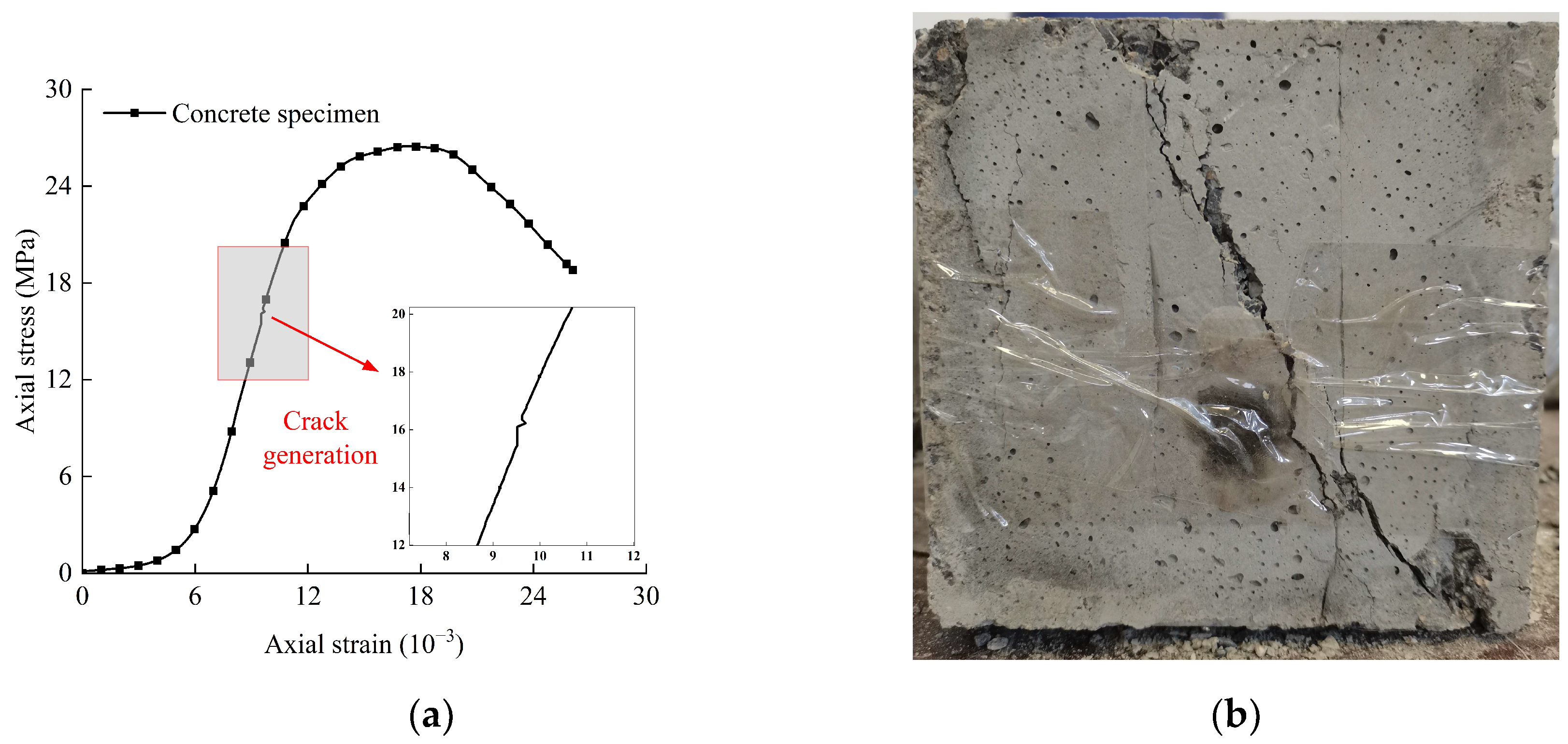
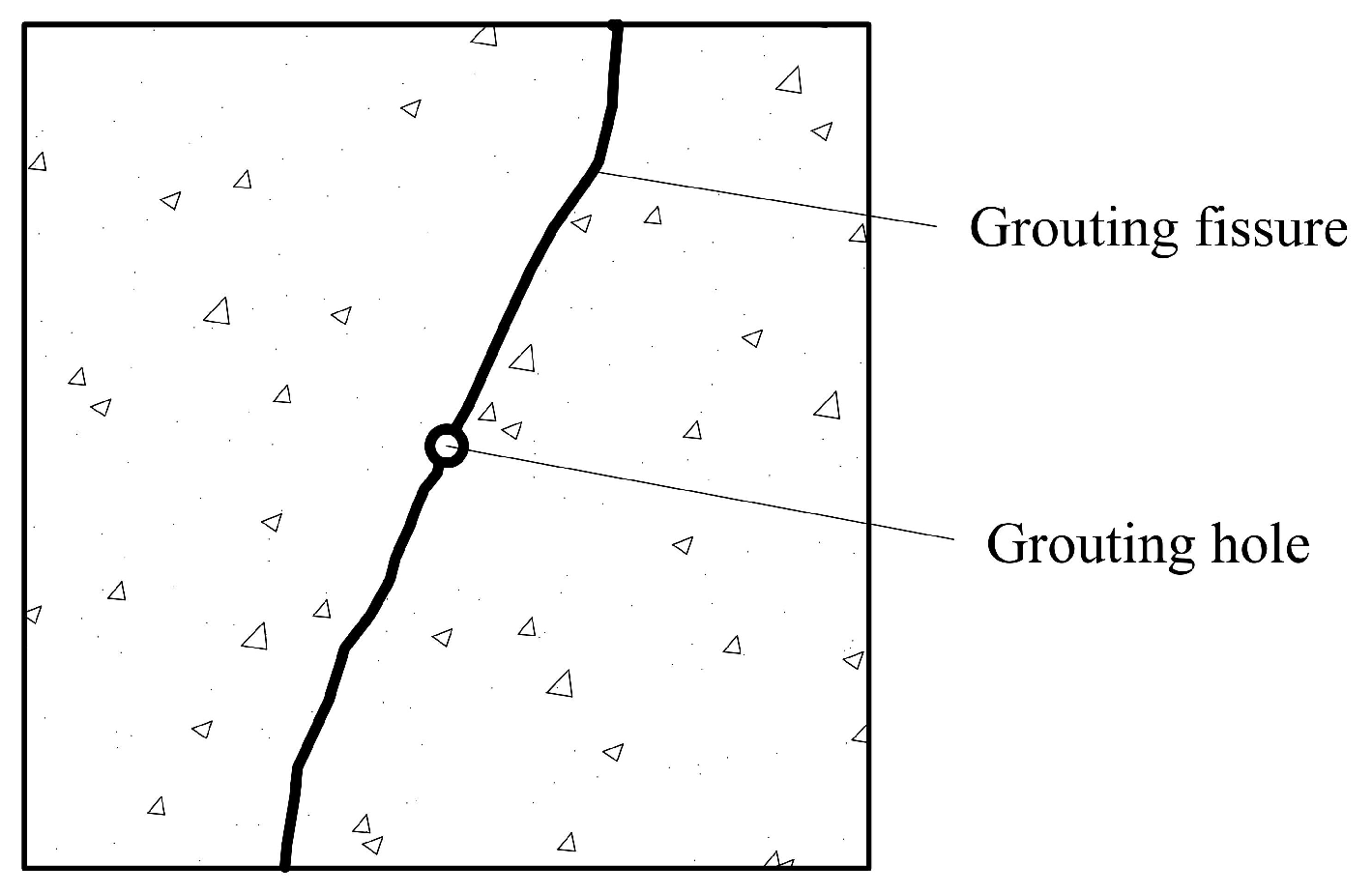
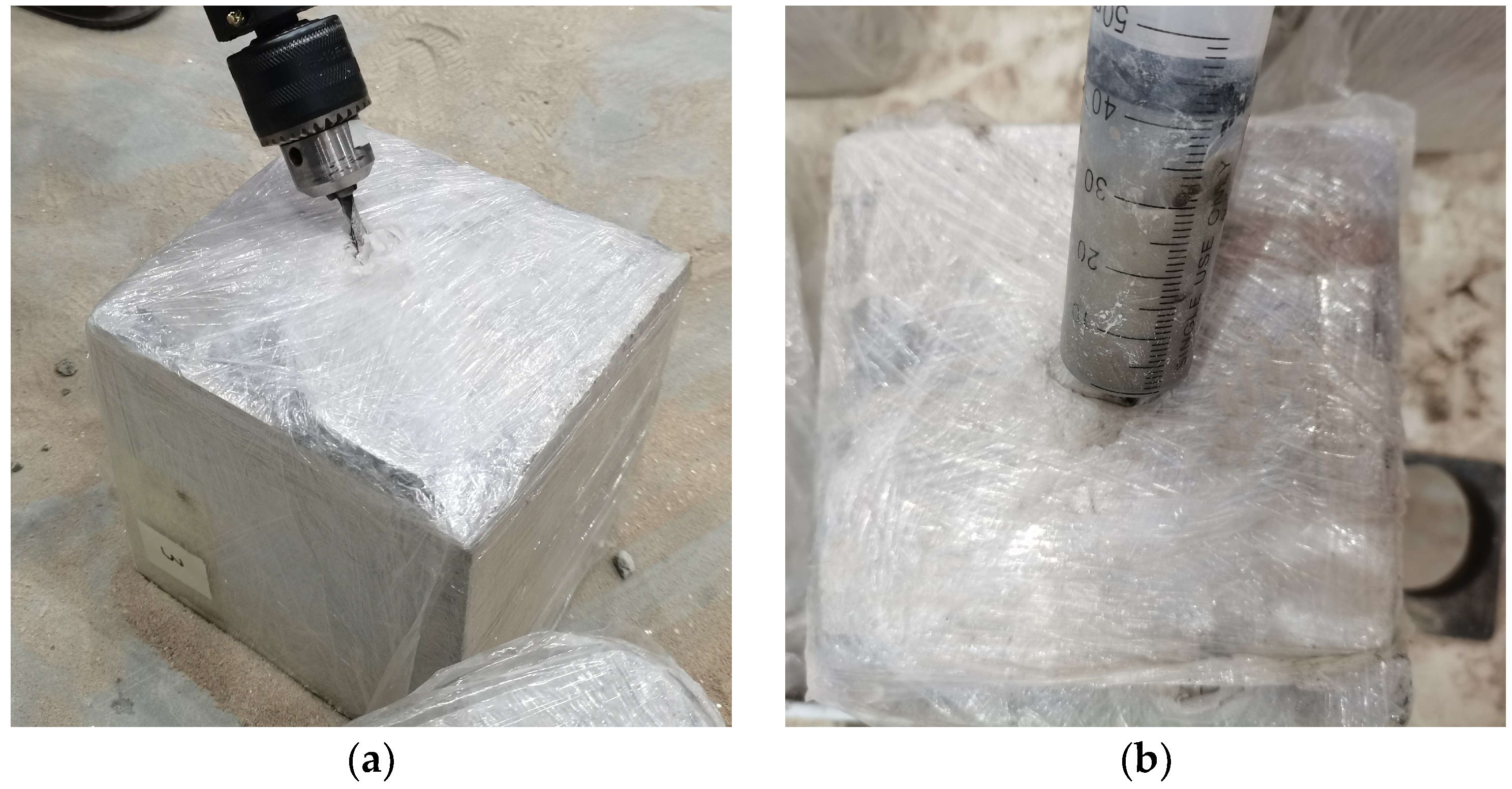
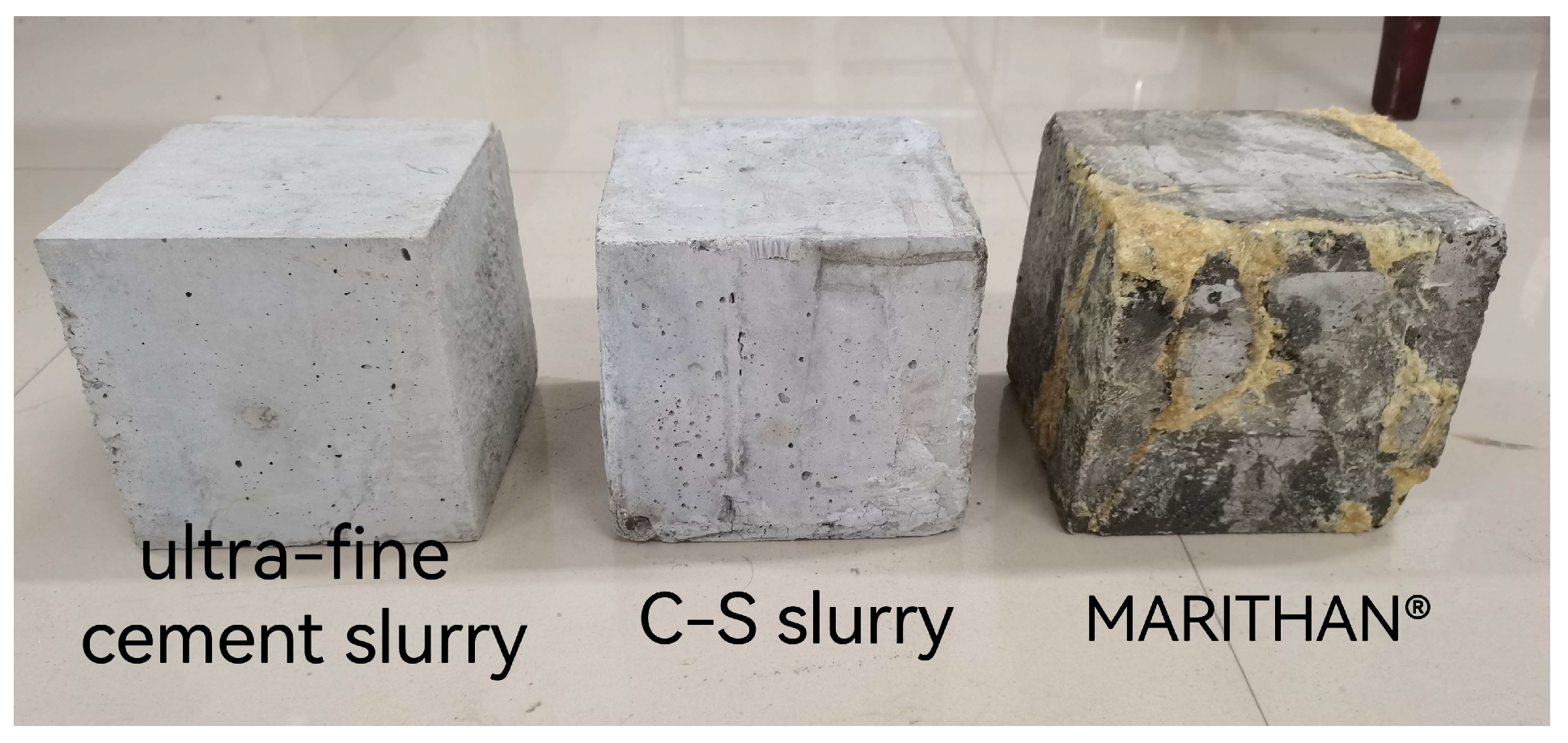
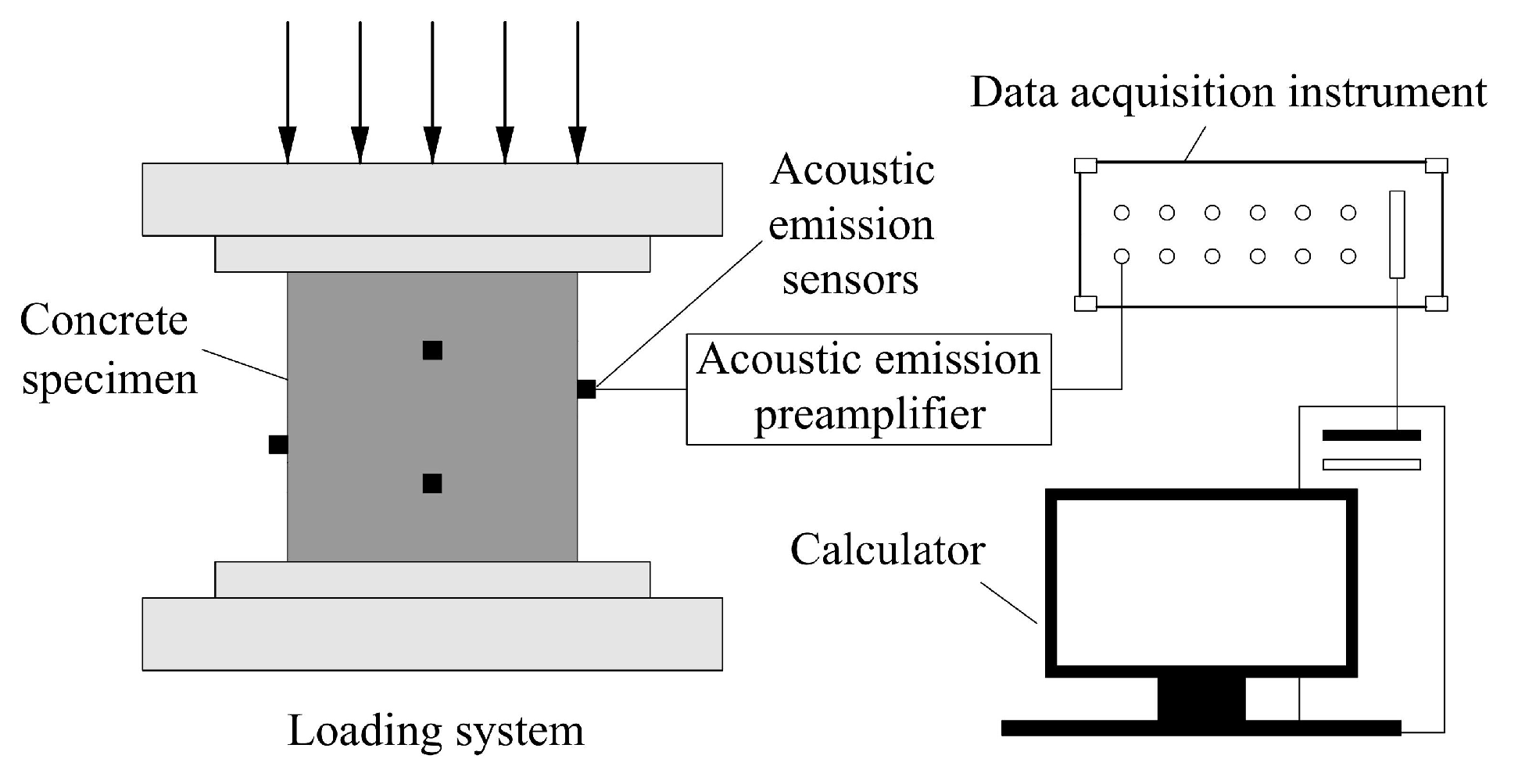
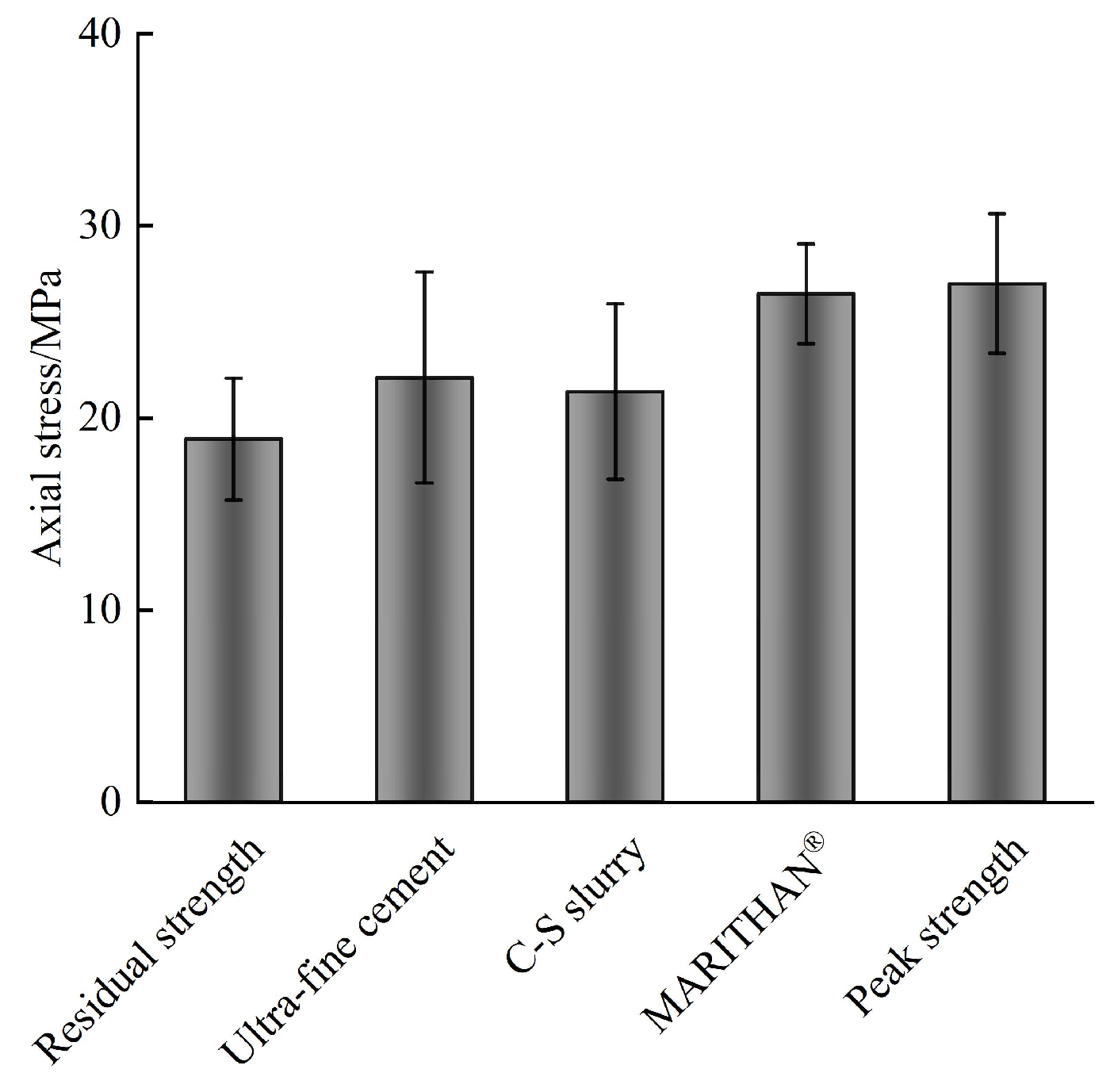






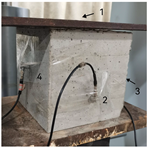 |  | Sensor Number | Coordinate | ||
| X | Y | Z | |||
| 1 | 75 | 0 | 100 | ||
| 2 | 75 | 150 | 50 | ||
| 3 | 0 | 75 | 70 | ||
| 4 | 150 | 75 | 80 | ||
| Specimen Number | Peak Strength | Residual Strength | Average Peak Strength | Average Residual Strength |
|---|---|---|---|---|
| A-1 | 27.595 MPa | 19.078 MPa | 26.987 MPa | 18.906 MPa |
| A-2 | 21.697 MPa | 13.925 MPa | ||
| A-3 | 31.666 MPa | 23.685 MPa | ||
| B-1 | 22.323 MPa | 14.718 MPa | ||
| B-2 | 24.386 MPa | 18.192 MPa | ||
| B-3 | 31.293 MPa | 22.314 MPa | ||
| C-1 | 26.481 MPa | 18.791 MPa | ||
| C-2 | 29.697 MPa | 18.768 MPa | ||
| C-3 | 27.743 MPa | 20.681 MPa |
| Grouting Material | Specimen Number | Uniaxial Compressive Strength | Average Uniaxial Compressive Strength | Peak Strength Enhancement Coefficient | Residual Strength Enhancement Coefficient |
|---|---|---|---|---|---|
| Ultra-fine cement slurry | A-1 | 24.103 MPa | 22.107 MPa | −18.083% | 16.931% |
| A-2 | 15.896 MPa | ||||
| A-3 | 26.323 MPa | ||||
| C-S slurry | B-1 | 16.354 MPa | 21.378 MPa | −20.784% | 13.075% |
| B-2 | 22.487 MPa | ||||
| B-3 | 25.293 MPa | ||||
| MARITHAN® | C-1 | 24.753 MPa | 26.468 MPa | −1.923% | 39.998% |
| C-2 | 29.453 MPa | ||||
| C-3 | 25.197 MPa |
| Type of Specimen | Cumulative AE Energy | Peak Axial Stress | Peak AE Energy |
|---|---|---|---|
| the intact specimen | 2,448,528 mV∙ms | 26.481 MPa | 21,430 mV∙ms |
| the ultra-fine cement grouting specimen | 9,877,722 mV∙ms | 24.103 MPa | 106,431 mV∙ms |
| the C-S grouting specimen | 1,893,329 mV∙ms | 22.487 MPa | 27,316 mV∙ms |
| the MARITHAN® grouting specimen | 1,268,946 mV∙ms | 25.197 MPa | 19,864 mV∙ms |
Disclaimer/Publisher’s Note: The statements, opinions and data contained in all publications are solely those of the individual author(s) and contributor(s) and not of MDPI and/or the editor(s). MDPI and/or the editor(s) disclaim responsibility for any injury to people or property resulting from any ideas, methods, instructions or products referred to in the content. |
© 2023 by the authors. Licensee MDPI, Basel, Switzerland. This article is an open access article distributed under the terms and conditions of the Creative Commons Attribution (CC BY) license (https://creativecommons.org/licenses/by/4.0/).
Share and Cite
Yu, Z.; Song, C. Mechanical and Acoustic Emission Characteristics of Grouted Reinforcement in Fissure-Containing Rock-like Specimens. Appl. Sci. 2023, 13, 11661. https://doi.org/10.3390/app132111661
Yu Z, Song C. Mechanical and Acoustic Emission Characteristics of Grouted Reinforcement in Fissure-Containing Rock-like Specimens. Applied Sciences. 2023; 13(21):11661. https://doi.org/10.3390/app132111661
Chicago/Turabian StyleYu, Zhonglin, and Chenchen Song. 2023. "Mechanical and Acoustic Emission Characteristics of Grouted Reinforcement in Fissure-Containing Rock-like Specimens" Applied Sciences 13, no. 21: 11661. https://doi.org/10.3390/app132111661
APA StyleYu, Z., & Song, C. (2023). Mechanical and Acoustic Emission Characteristics of Grouted Reinforcement in Fissure-Containing Rock-like Specimens. Applied Sciences, 13(21), 11661. https://doi.org/10.3390/app132111661








